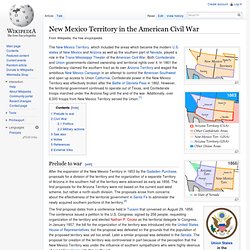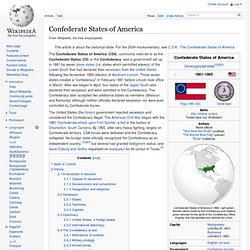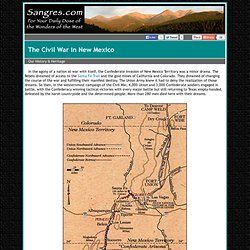

New Mexico Territory in the American Civil War. Prelude to war[edit] After the expansion of the New Mexico Territory in 1853 by the Gadsden Purchase, proposals for a division of the territory and the organization of a separate Territory of Arizona in the southern half of the territory were advanced as early as 1856.

The first proposals for the Arizona Territory were not based on the current east-west scheme, but rather a north-south division. The proposals arose from concerns about the effectiveness of the territorial government in Santa Fe to administer the newly acquired southern portions of the territory.[2] The first proposal dates from a conference held in Tucson that convened on August 29, 1856. The conference issued a petition to the U.S. However, due to the small number of inhabitants in the proposed territory, the U.S. Civil War[edit] Politics[edit] Early in war, the Confederacy regarded the territory as a valuable route for possible access to the Pacific Ocean, with the specific intention of capturing California. Notes[edit] Union (American Civil War) The flag of the United States from 1861-1863.

The southern states were still represented in the number of stars in the flag, since their secession from the Union was considered illegal in the north. In 1863, a star was added to represent the new state of West Virginia. Confederate States of America. The Confederate States of America (CSA), commonly referred to as the Confederate States (CS) or the Confederacy, was a government set up in 1861 by seven slave states (i.e. states which permitted slavery) of the Lower South that had declared their secession from the United States following the November 1860 election of Abraham Lincoln.

Those seven states created a "confederacy" in February 1861 before Lincoln took office in March. After war began in April, four states of the Upper South also declared their secession and were admitted to the Confederacy. The Confederacy later accepted two additional states as members (Missouri and Kentucky) although neither officially declared secession nor were ever controlled by Confederate forces. Span of Control[edit] The U.S. The war left the South economically devastated by military action, ruined infrastructure, and exhausted resources. History[edit] Evolution of the Confederate States A revolution in disunion[edit] Causes of secession[edit] And again:
Civil War Guns. The tactics at the beginning of the Civil War were left over from the smooth bore musket.

The advent of the rifled musket tripled the effective range of the infantry. The artillery had to back up to move further away. There was much experimentation starting just before the Civil War with breech loading guns. There were many models of breech loading carbines for the cavalry, but it wasn't until near the end of the Civil War that a serviceable metallic cartridge was made for a breech loading musket. General Information on Civil War Guns Common Guns in the Civil War More on the Civil War The National Park Service has added an excellent page on the Civil War Signal Corp at the website on the Battle of Antietam.
Let us know what you liked about our articles listed here and where you would like to see more information by contacting us. More is available on the Civil War generally. Civil War in New Mexico. September 9, 1861, US Territorial Governor Henry Connelly issued a call for service.

By January, 4,000 men had volunteered in New Mexico. These were mostly poor, illiterate, Spanish-speaking men, aged 18 to 45, from Las Vegas, Santa Fe, Taos, Mora, and other surrounding villages. They knew little of American military training. They were organized into 5 regiments composed of 5 to 10 companies (80-100 men per infantry or cavalry company). (That's Governor Connelly on the left.) They were assembled at Fort Union and at Albuquerque under the direction of officers like Christopher "Kit" Carson, Manuel Chavez, Ceran St. Fort Fillmore had been abandoned by the Union the previous July and was quickly occupied by Confederate troops moving in from West Texas. The Battle of Valverde was a Confederate victory and forced a Union tactical retreat.